
Just What Does It Take to Restore the American Chestnut Tree?
At the Annual Meeting of the Foundation of the State Arboretum in June, Dr. Laurel Rodgers, an American Chestnut researcher and Associate Professor in Cell Biology at Shenandoah University, shared her update on the plight of the American chestnut tree.
The news is good: “We’re currently entering a period in which multiple research projects are coming together and restoration of the American chestnut tree is looking more obtainable,” Dr. Rodgers says.
While discussing her own microbiome work, Dr. Rodgers also presents recent breakthroughs in American chestnut restoration research, including hypovirulence, hybrid tree breeding programs, and genetic modification.
Hear her discussion of the most recent research and how the chestnut orchards at Blandy Experimental Farm are being used to help the American Chestnut Foundation in its restoration efforts. Click here
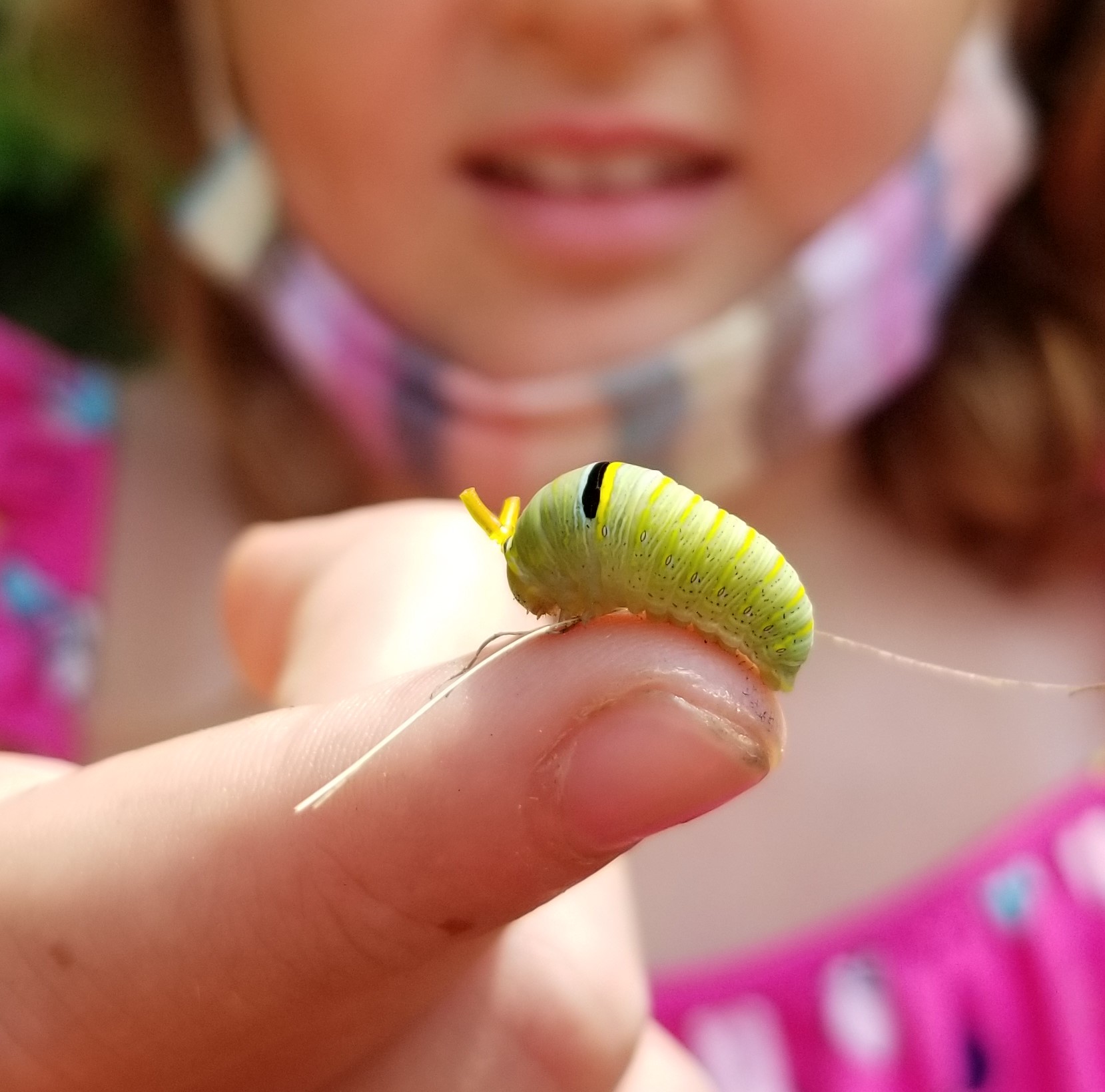
Do You Want to Help Improve Our Understanding of Nature? It’s Easy!
by Emily Ford, Lead Environmental Educator
The Arboretum’s variety of plants, gardens, and habitats offer nearly infinite opportunities to discover and learn. Each time you visit Blandy Experimental Farm and the State Arboretum of Virginia, you can contribute towards documenting the diversity of organisms!
iNaturalist is a global network of people sharing photos and biodiversity information to help communities learn about nature and help scientists better understand the natural world.
In the iNaturalist app, you start by making an observation, snapping a photo (be sure your geolocation is tagged), and uploading the image to iNaturalist. Because of the location tag, it is automatically added to Blandy’s project.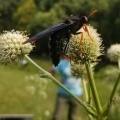
https://www.inaturalist.org/projects/blandy-experimental-farm
The app gives suggestions on identification. You can use the suggestions or add the photo without any identification. If no ID is added, fellow naturalists who use iNaturalist will help with identification of what you observed. Pictured are a couple of the amazing organisms found this summer and entered into the project. What will you discover?
A Unique – but Productive – Summer of Research at Blandy
“Almost 250 undergraduates have moved through Blandy programs during my time here, and most of them find the experience life changing.”
By David Carr, Director of Blandy Experimental Farm
The summer research season has wrapped up at Blandy, and all went well. We began planning for the summer back in January, and we were forced to assume the state of the pandemic would not be any better when our students arrived in May. In the end, though, it turned into a pretty normal summer. One of the programmatic changes we made in response to the pandemic was to host all our Wednesday night seminars via Zoom. Although I missed the in-person experience, this approach did have one advantage: We were able to invite speakers from anywhere, rather than relying on a local pool of speakers, as we do most years.
We used this unique opportunity to catch up with some scientists who passed through Blandy while they were undergraduates. One of the primary goals of our National Science Foundation-funded Research Experience for Undergraduates (REU) program is to train the next generation of scientists, so it was exciting to see many of our alumni advancing in their careers.
Our first speaker of the summer was Dr. Helen Curry, who was an REU student at Blandy in 2002 when she was an undergraduate at Harvard. Helen worked with then Blandy Director Michael Bowers doing butterfly surveys in Clarke County. Since leaving Blandy and completing her degree at Harvard, Helen went on to do her Ph.D. work at Yale on the history of radiation in plant breeding during the Cold War. This topic brought her back to Blandy as a grad student to study the work of Dr. Ralph Singleton, Blandy’s former Director who experimented with irradiated corn from 1955 to 1965.
Helen is now a Senior Lecturer at the University of Cambridge, where she is currently researching the history and philosophy of seed banking. By the way, I should mention that Helen’s 2002 REU classmate at Blandy was Daniel Hanley from Cornell University. Daniel completed his Ph.D. at the University of Windsor, where he studied bird vision and its role in the evolution of egg coloration. Dr. Hanley has come full circle now. He is an Assistant Professor at nearby George Mason University, and this summer he and a Blandy REU student evaluated the ability of birds to recognize eggs from brood parasites (e.g., the Brown-headed Cowbird) based on the similarity in color to their own eggs.
Carla Vanderbilt was an REU student at Blandy back in 2009 when she worked with me studying the relationship between age and song complexity in Gray Catbirds. Carla’s interest in birds carried on into graduate school, earning her Ph.D. at Florida State University studying the courtship dances of the incredible Lance-tailed Manakin in Panama. Dr. Vanderbilt is now an Assistant Professor of biology at the University of Pikeville in Kentucky where she is teaching a new generation of students (many first-generation college students) the skills needed for biological research.
Roberto Carrera-Martinez worked with my graduate student Gerry Woodworth on the distribution of earthworms at Blandy during his time as an REU student in 2013. He came to us from the University of Puerto Rico at Mayaguez. Roberto’s fascination with earthworms has stayed with him through graduate school, and in his seminar this summer, he shared the discoveries he made (including a new species) as a Masters student at the University of Georgia. He is continuing his work on earthworms as a Ph.D. student at the University of Wisconsin. Dr. Woodworth, by the way, is now an Assistant Professor of biology at Mid-Atlantic Christian University.
The REU program has not been the only undergraduate training program at Blandy. Dr. Mary McKenna often brings undergraduates to Blandy from her home institution at Howard University, especially as part of Howard’s Environmental Biology Scholars program. Many of these students have now entered graduate school or have moved on to postdoctoral studies, and we were able to catch up with three of them in seminars this summer. Alexandria Igwe studied plants that grow on serpentine soils (naturally rich in toxic heavy metals) with Dr. McKenna in 2011. At the University of California at Davis, she continued studying how plants cope with serpentine soils in earning her Ph.D. in 2020. She is now a postdoctoral researcher at the University of Miami. As a Ph.D. student at the University of Michigan, Nia Johnson (Environmental Scholar 2012) is studying the effects of pesticide drift from crops to natural plants and the effects of these pesticides on the interactions between non-crops and their herbivores. As a Ph.D. student at the UC Davis, Erin Manaigo (Environmental Scholar 2013) is studying soil mineral supplements and their potential value for increasing carbon sequestration in the soil on agricultural land. This work could have important implications for the reduction of atmospheric carbon dioxide and slowing global temperature rise.
No experience in my professional career has given me more pleasure than getting to watch a new crop of undergraduates each year take charge of a research project for the first time in their lives. Almost 250 undergraduates have moved through Blandy programs during my time here, and most of them find the experience life changing. While not all go on to careers in sciences, the experience during their summer at Blandy has been formative to the vast majority. Their talents and the passion I get to see each summer is one of the things that makes me hopeful for the future.
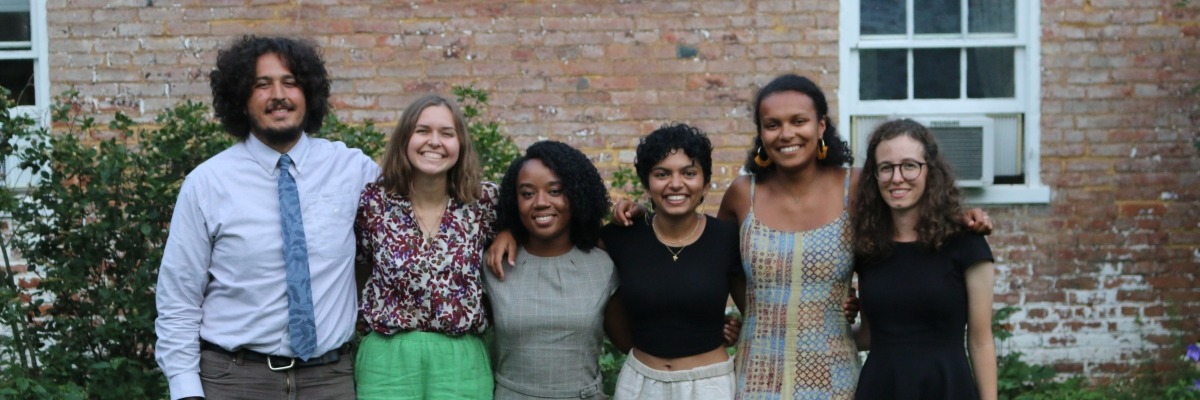
Undergraduate Student Researchers Explore Environmental Mysteries at Blandy
In August, we once again bid farewell to our latest cohort of undergraduates who studied at Blandy as part of the Research Experience for Undergraduates (REU) program. This year, the number of students decreased from 10 to six because of pandemic safety measures. But the quality of the summer research was excellent, as usual.
The goal of the REU program is to provide promising undergraduates with exposure to and experience in field research, led by mentors who are faculty from several universities, including the University of Virginia faculty at Blandy. The program is overseen by Dr. Patrick Crumrine of Rowan University and is funded by the National Science Foundation and Blandy Experimental Farm.
In 2021, these talented students presented their summer research at the close of the session:
■ Clara Cebral-Marani of George Mason University – The role of host color perception in egg recognition
■ Anna Gilmore of Rockhurst University – Effects of algal abundance and plant habitat complexity on intraguild predation among aquatic insects
■ Syntyche Kane of Howard University – Ants on plants: Costs and benefits of extrafloral nectaries in Black-eyed Pea
■ Zane Molins of Worcester Polytechnic Institute – Soil Nematodes impact above-ground herbivory on Dogbane and Common Milkweed
■ Mia Murray of Wheaton College – Testing pollen-host specialization in the Texas Mason Bee
■ Jaya Nagarajan-Swenson of Mount Holyoke College – Does individual foraging efficiency reflect overall hive success in three different habitat types in the Common Eastern Bumblebee?
After presentation of their findings at the 34th Annual Research Forum, Nagarajan-Swenson was awarded a prize for the Best Talk, and Mia Murray earned a prize for Most Creative Project.
Remembering the Enslaved at the Tuleyries: The Research Begins
Remembering the Enslaved at the Tuleyries: The Research Begins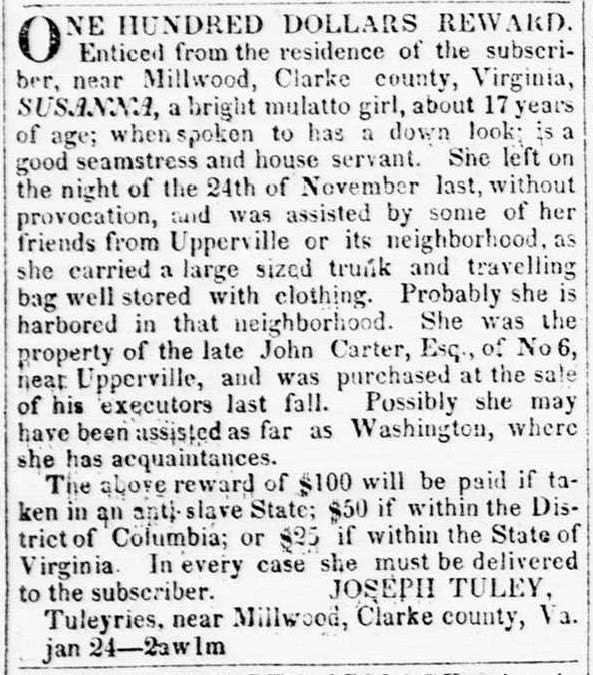
“ONE HUNDRED DOLLARS REWARD. Enticed from the residence of the subscriber, near Millwood, Clarke county, Virginia, SUSANNA, a bright mulatto girl, about 17 years of age; when spoken to has a down look; is a good seamstress and house servant.”
This is part of an ad that appeared in an 1844 issue of the Alexandria Gazette, placed by Joseph Tuley, owner of the Tuleyries, seeking to reclaim the enslaved Susanna. Susanna escaped “with a large sized trunk and travelling bag well stored with clothing,” the ad continued. Tuley suspected she had traveled as far away as Washington, D.C. “where she has acquaintances.” (The full advertisement is shown in the article.)
The newspaper ad is a small part of the history uncovered by Antonio Austin, a PhD student at Howard University who spent this summer as an intern at Blandy Experimental Farm researching the enslaved at the nearby Tuleyries estate.
The Tuleyries was later owned by Graham Blandy, who in 1924 bequeathed more than 700 acres of the surrounding land to the University of Virginia to become Blandy Experimental Farm. A portion of the historic brick Quarters building at Blandy served as housing for the enslaved people working at the Tuleyries, the topic of Antonio’s research. It now holds the offices of Blandy and the State Arboretum of Virginia.
Antonio notes his summer research is just the beginning of what he expects will be a longer-term project: “I truly hope Blandy continues to look for and find more information. Maybe the descendants of slave-holding families in the area eventually will donate materials into the public domain so it can be accessed. That will allow researchers to try to connect people with surnames in descendant groups. There may be a missing piece of the puzzle – from photos, oral history, something we haven’t found yet.”
Antonio’s research included trips to the courthouses in Clarke and Frederick Counties, scouring pages and pages of records, as well as to the Library of Virginia in Richmond. He also worked closely with the Clarke County Historical Association and local historian Maral Kalbian, taking advantage of their local knowledge and guidance.
But there were challenges.
“When you’re researching history like this, it’s not like walking in the front door and finding the information you need. It’s like hopping through a window and maybe even a window on the second floor,” Antonio laughs.
While exploring archives of wills, census records, estate records, and reports of court cases, he discovered quite a bit of inaccurate information. “For instance, with census records, so much depends on the census takers,” Antonio explained. “They had different census instructions. And sometimes a child provided the information, or even a neighbor. And they weren’t always right.”
His most fascinating find? “Discovering the ad for Susanna was amazing – and it had been published at least five times in a month,” Antonio said. “So Joseph Tuley was desperate to find her.”
Like so many other open questions about the enslaved at the Tuleyries, Antonio’s exhaustive research never uncovered Susanna’s fate.
Listen to Antonio’s full presentation about his summer research at Blandy here.
Don’t Miss Our Slate of Fun Fall Programs!
Hankering for a bird walk? Or a guided trek in the moonlight? Or a primer on fall tree care? Blandy has these – and more! – educational fall programs lined up for your enjoyment. Visit Upcoming Events to learn more, including what to expect, what to wear, where to meet, and how to register.
Like ginkgoes? Love people? We need your help!
Blandy’s glorious, golden Ginkgo Grove attracts thousands of visitors each fall – many of whom are visiting Blandy for the first time. We are actively recruiting volunteers (“Ginkgo Guides”) to help introduce visitors to the Ginkgo Grove and to Blandy’s grounds this fall.
Ginkgo Guides should expect to attend a two-hour orientation session Sunday, October 3, from 2:00 to 4:00 PM, and to work one or more three-hour shifts during weekends in October and early November. The training session will cover:
■ The ginkgo’s unique evolutionary history and biology
■ The history of Blandy’s Ginkgo Grove
■ Tips to help visitors enjoy the Grove safely
To learn more and sign up, please contact Ariel Firebaugh, Director of Scientific Engagement at alf7f@virginia.edu.
GinkgoFest, a New Event to Celebrate Our Golden Ginkgoes!
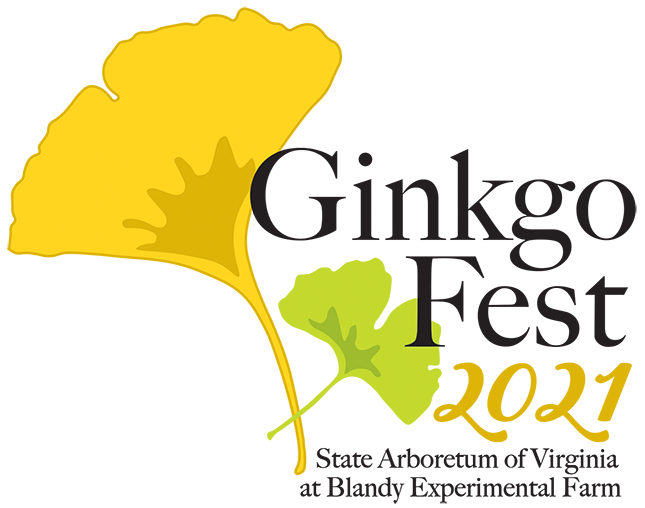
Music and cocktails under the stars in Blandy’s illuminated Ginkgo Grove? Sounds heavenly to us, too. Stay tuned for more information on this special ticketed event – GinkgoFest – the evening of October 23 at Blandy. (Pssst. We’ll also be hearing from world-renowned ginkgo expert Sir Peter Crane. So it’s not only magical but educational. A can’t-miss!)
Bring Some Seeds, Take Some Seeds 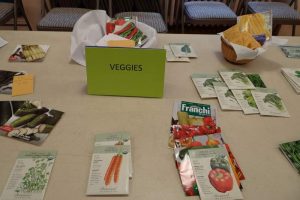
The Seed Exchange Is Back at Blandy – January 29, 2022
Oh, how we missed the chance to trade seeds with like-minded gardeners this past January. But the wonderful Seed Exchange, organized by the Northern Shenandoah Valley Master Gardener Association, will be back on January 29 of 2022. Mark your calendar now for a fun-filled visit when you’re bound to take home seeds to grow vegetables, herbs, perennials, annuals, vines, woody plants, and more. (And start gathering your own seeds to exchange!) More details at https://nsvmga.org/events/seed-exchange/
Blandy Is Hiring – and You May Be the Perfect Fit!
Imagine working at one of the most beautiful places in the country. Blandy Experimental Farm and the State Arboretum of Virginia is hiring!
After several recent retirements, we have job openings that span from grounds worker to service technician to arboretum specialist to public relations and marketing coordinator. Visit https://blandy.virginia.edu/job-opportunities to see if there’s a fit for you or someone you know.
